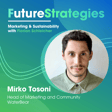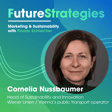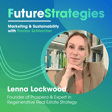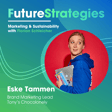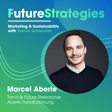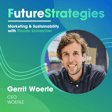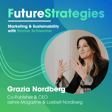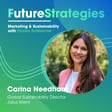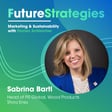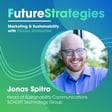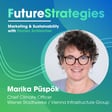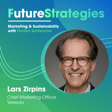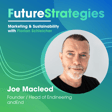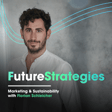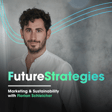IKEA's Mission and Sustainability Efforts
00:00:00
Speaker
IKEA's mission is a better everyday life for the many people. A better home is not just the home you live in, but also the planet. and So how can we enable customers to be more sustainable? yeah And it's not just about products. We sell them. It's also about how we operate as a company.
00:00:17
Speaker
Welcome to the Future Strategies
Introduction to the Podcast and Host
00:00:19
Speaker
podcast. My name is Florian Schleicher. I'm a marketing strategist focused on sustainability, and I'm your host here. Every two weeks, you can listen to my interviews with international experts, and together we will explore where marketing strategies and sustainability intersect with great examples, insightful stories, and a look behind the scenes of some amazing brands.
Florian's Work in Sustainable Marketing
00:00:42
Speaker
If you're curious how to apply all of that for your own business, I do this for my clients from all around the world through inspiring workshops, guiding mentoring and an exciting on online academy. But more on that at the end of this episode.
Introducing John Oakley, IKEA Austria Marketing Manager
00:00:55
Speaker
Now, let's jump into today's interview. My guest today is the country marketing and consumer insights manager at IKEA Austria.
00:01:04
Speaker
John Oakley studied marketing at a university in England. Before joining IKEA, he was CEO of a major international advertising agency. He has over 20 years in advertising and marketing. The mission that John has been passionately following at IKEA is a better everyday life for the many people through better homes and a better planet.
00:01:27
Speaker
In 2022, he and his team launched IKEA's new brand positioning platform, LibSmart, or LiveSmart, to strengthen the brand's differentiation and purpose on the Austrian market. John, it's a pleasure to have this conversation with you today here.
John's Personal Experience with IKEA
00:01:44
Speaker
Yeah, thank you Florian. Thank you for inviting me. I'm very happy to be here. Before we start, I would be super curious, what does the room look like where you are at the moment and how many IKEA furniture elements are there?
00:01:57
Speaker
What a great question. and Yes, I'm in my new house. So we built this house 11 months ago. So I would say we're still in the middle of furnishing, but I have had many, many trips to IKEA, as you can imagine, to decorate and furnish the home.
Journey to IKEA and Love for the Brand
00:02:15
Speaker
So I mean, if I count IKEA furniture right now, I'd say we're up about five pieces and six pieces in this room. Can you name all of them?
00:02:26
Speaker
He has a very comfy chair I'm sat on. Then I've got a sofa bed and a footstool because this is an office, but also a guest room. So it needs to be a multifunctional room. yeah Then I've got the good old trusty Malm Komoda there in the corner, which we brought from our old house. Every good household should have one of these, shouldn't they? Exactly. It's kind of a ah rite of passage. And then I've also got a a nice little table in a leaf shape where the printer sits. Nice. I like that. So you obviously work for IKEA, super exciting brand to also work for. And it's also a love brand. What makes IKEA such a great place for you to work at?
00:03:13
Speaker
Well, I always loved IKEA. I think like like many people, you grow up with it. Your parents, my parents took me to IKEA as a kid and it was always a great fun place to go to, to see and play and imagine in all of the room settings that we have.
00:03:29
Speaker
Imagine that's your room and you live there. Of course, the meatballs and the ice cream, that was always fantastic. I always had a very positive view of IKEA. Also then, as an adult, seeing how they operate and knowing that it's a love brand. As a professional in the advertising industry, originally on the agency side, I wanted to have them as a client. I also thought by If a job ever came up in IKEA in marketing, it was definitely something I would go for. 2019, that's exactly what happened. and I was running an advertising agency at the time, so I had already quite a good and challenging job, but I thought you know now or never, you got to try and see if you can so as they meet your hero and see if IKEA will take you. Thankfully, it was successful.
00:04:22
Speaker
I can very much relate to that. As I told you in the beginning, I worked for McDonald's and for me coming fresh from university, it was always a dream to either work for McDonald's, Coca-Cola or Nike. Those were my dream brands.
Maintaining IKEA's Brand History
00:04:36
Speaker
So I was super happy starting at McDonald's. And I think also at IKEA, these are the brands that once you have worked for them, first you learn so much. I'm deeply grateful for everything that I've learned.
00:04:48
Speaker
And you really get a good experience on what brand building means because so everybody knows those brands. And it's such a responsibility also to carry that torch forward. It really is. a you You do feel a responsibility, like you say, because it has such a long and proud history. And you see also how much customers love your brand and how invested they are in it, which is which is a really nice thing to see. But as you say, you know you need to respect that.
00:05:14
Speaker
and ah use it to your advantage but make sure you carry the torch so that you can add it on to the next person in good shape.
Marketing Awards and Campaign Success
00:05:21
Speaker
Exactly. So you and your team, we are recording this in autumn of 2024. You are currently on a winning spree of marketing and advertising awards. Which of the awards, which of denominations are you particularly proud of?
00:05:36
Speaker
I would say you know we don't in the daily business, don't set out to win awards per se. you know We're always just looking at how can we you know capture the attention of our customers and make them love us and do exciting things that we're we're excited about. so Awards are always a ah really nice thing then to have you know because then that shift shows that the work you're doing is being seen and being recognized by your peers or your well people are out there in the in the market.
00:06:05
Speaker
so that I think they all have a ah certain value. Probably the the ones that we're proud of the most is the nominations for the FEs. These are from the International Advertising Association.
00:06:20
Speaker
And they're not just based on the images that you have and how the campaign looks, but also what the campaign achieved as well. yeah So we've got this time four nominations for the F East this year. And we're super proud about that because that's a really hard one to even get
The 'LiveSmart' Campaign
00:06:36
Speaker
one. So to have four is already a ah huge win for us.
00:06:40
Speaker
Yes, that's the biggest honor. While I was working for Too Good to Go, we had this one campaign on date labels, and the year was 2021, and we won four of the FVs. Oh, fantastic. Yes. ah That campaign, that was just magical that whole evening. It felt like the whole team and I were just flying through the event venue. Yeah, absolutely. No, and it's exactly that. It's the you know it's for all the hard work.
00:07:08
Speaker
And often, you know, these campaigns that get such recognition, what people don't realize is they're often the ones that are the hardest to get off the ground because they take a lot of convincing of internal stakeholders or agency partners or what have you. know Because they're unusual, yeah you have to sometimes really dig deep to to make them happen. So can you walk us through a little bit of the campaign that is nominated for the FES?
00:07:36
Speaker
One of the ones we're extremely proud of is for Labor Smart. This is something that when I came to IKEA, we one of the first things we worked on was ah an agency pitch. so We were looking for an agency partner who could help us to have more consistency on the market, which is hugely important these days. As marketeers, we worked across so many different channels.
00:08:01
Speaker
And being a worldwide company, maybe the same at McDonald's, you get a ton of content from all over the world. And a lot of it obviously fantastically good. But one of the problems we were seeing is that all of it looked very different. So if you pick and choose from different countries, then You have different brand cues, different music, different taglines, and we were just lacking this consistency. And we said, okay, well, you know, we can't solve the fact that we're going to get a lot of content going forward, ah because we're not in control of all the content we do. Thankfully, like here you are, you do have quite a lot of control.
00:08:38
Speaker
on a local market level, but we wanted this consistency for the brand. So we did a ah pitch looking for that. And Amdas won, and they pitched us at that time, believe it or smart, as ah as a claim that came really from the core of the brand. Looking at here is all about smart shopping. and Customers, and they they said you know they did interviews with people, and people were taking them around their house saying,
00:09:06
Speaker
Yeah, you know I bought this chair from IKEA. It only cost me 50 euros. and Isn't it fantastic? It doesn't look great. I'm really proud of it. and They realized that people are super proud that they bought something special at IKEA and not paid very much for it. You know you always have a feeling I've i've made this this great deal. and That's what we wanted to really try and strengthen more and more with that and take this sort of feeling of IKEA stronger into our appetizing across everything we do and this is what's now being awarded or hopefully will be awarded let's see but nominated ah definitely for the f FE and that was like I said a few moments ago one of the ones that took a lot of
00:09:48
Speaker
digging deep and working hard and persuading people,
The 'Worst Sleepover Ever' Campaign and Social Media Trends
00:09:52
Speaker
you got to trust me on this. This is going to be good. Yeah. Yeah. I think like the best campaigns and the most successful ones are the ones who actually solve a problem for a target audience. So that means really being built on a deep inside.
00:10:07
Speaker
One of the current campaigns that you're running or the campaign that you also did during the summer was a lot about sleeping. And you also did, for example, this influencer campaign with sleepover events at IKEA titled worst sleepover ever. What was the insight that that campaign was built on?
00:10:26
Speaker
When we had the topic of sleep, we knew that sleepovers at IKEA, they'd been done a few times previously. So customers could sleep over at IKEA and then take the ah mattress, for example, they were sleeping on home with them. And that was, they were super successful events in the past. And so but we wanted to give this a bit more of ah a modern update. And we, you know, looked at it and basically the the insight what behind it was there was a social media trend at the time about worse sleepovers.
00:10:56
Speaker
ah So people posting pictures of them asleep on the floor with a towel, a hand towel over them, you know or sleeping under the rug because and they're sleeping. They've had a party or something and they're sleeping at their friend's house and it's cold in the middle of the night. So there was some very funny social media posts around that. And so we thought that would be it'll be great to combine those two things. you know An iconic Ikea activity with a you know very social media relevant, Gen Z relevant topic, and that's where it all started.
Success on TikTok with User-Generated Content
00:11:29
Speaker
Very interesting. Let's stay with social media a little bit longer because what I find completely fascinating is your brand's overall TikTok strategy. And I don't know if you've stumbled upon this as a brand or it was
00:11:44
Speaker
driven by you guys, but what I see is TikTok is of course all about authenticity and user generated content. And nowadays there are hundreds of thousands of content pieces where users share their do-it-yourself hacks and how they use IKEA furniture to create something else in a creative way. How much is that actually an active part of your influencer and social media strategy, or is it just brand love in action?
00:12:12
Speaker
It's more the second, it's more brand love in action, to be very honest. It's because we are this this love brand, but also because if you shop at IKEA, you automatically, you're ah what we call a smart creator. right so You take the furniture home with you in a box and you build it. You know you you've may have been inspired by something you've seen in the store that you want to recreate at home as well. so you know We can give you the the tools, the solutions,
00:12:40
Speaker
to create something yourself. yeah Either you're just simply building a packs or a table, or you're combining different elements to make a a complete solution. And this is kind of part of our DNA. So I think that lends itself really well to content online where people who are already creative can say, well, you know, I can maybe take it a bit further and add my own little touch to it and make it into something even more special that really fits to me. So, you know, it's something we definitely proud of and love to see, but yeah, it's definitely something we don't always do ourselves because we're obviously selling you more the ah solution that we've, that we want to sell you. And, but we're very proud when someone wants to add their own individuality to it as
Creativity During Financial Challenges
00:13:27
Speaker
yeah and And coming back to the thing that we discussed before, that brands need to figure out where they actually fit into people's lives and not the other way around. I think this is spot on to just use that potential when people realize what they can do with all the amazing products that you have.
00:13:47
Speaker
and I saw that in 2024, you also started this new global marketing campaign called Do Try This At Home to show the creative way how IKEA can support its customers, especially also in overcoming financial challenges in everyday life by lowering prices.
00:14:04
Speaker
And you did not only communicate this, but also inspire your customers to sort of like rebel in their own homes and make most of every moment. And that seems like a spot on approach on an actual needs because everybody is suffering from cost of living and price increase. How does this campaign, this do try this at home campaign so far play out for you?
00:14:29
Speaker
Well, it was the TV spot was, like I say, an international spot that we were running. And we tested it like we do all of our spots creatively with an audience. And we found that it actually had a very good rating. And and so it was very impactful. And what we loved about it was it was a slightly new approach, right? So we had ah quite an energy to it.
00:14:50
Speaker
and lots of different fast paced scenes and we also like the you know encouraging people to try more at home so you know from that point of view I think it it ticked quite a lot of boxes and we in Austria we also went a bit bigger with adding out of home to it and We put it across online video channels. And yeah, so it was it was it was quite a good one. And yeah, there should be also another iteration of that going forward as well. So we're waiting to see what that looks like. I'm curious. Talking about insights before, you are also customer insights manager. Do you have a favorite campaign that is not from IKEA, which you consider to be built on an excellent insight? one that's caught my eye recently is the Palmer's one, um which is Sexy Not Sorry. And I really like that campaign
Palmer's 'Sexy Not Sorry' Campaign
00:15:43
Speaker
because it firstly kind of
00:15:45
Speaker
punches you in the face. It's, it's really impactful, I think. And also just built on the inside of, you know, it doesn't matter what type of woman person you are, what body you live in, you should be proud of it. And everyone could be sexy. Yeah. know So I think that's, that's a really great insight. And I love the fact that it's, you know, coming out at this time where, you know, so many people are struggling with body positivity because of social media and Instagram and all these things.
00:16:13
Speaker
that it's you know giving people permission to be proud of themselves. I love that. I think it builds on the insight that also Dove had 10 plus years ago. It's very similar, yes.
00:16:26
Speaker
yeah but But really, ah first, we in Austria didn't really get a lot of coverage from that. And second, I think it takes it even one step further because it's about sexiness, not just feeling good, but one step further. Yes, ah exactly. And I think that that takes it one step further. And because of the products, they're selling you know lingerie and underwear.
00:16:47
Speaker
That's one of the big reasons that people have when they're buying, you know, they want to look yeah sexy, you know, because yeah, those are the intimate moments, e etc. So I think the the combination of the two is really good. And then I just like the, I just like the attitude that they gave to it as well. You know, I think brand like farmers used to be famous, didn't it for, for great marketing that it did in the past, then they, I don't know how many years seemed like they were too afraid to go down that route.
00:17:15
Speaker
And they were more conventional and someone obviously said, let's go back to day doing that. you know And it's it's brave and they they deserve a success from it. Yeah, it feels like they woke up from some kind of like winter ah beauty sleep yeah and now the brand is awake. And I'm really curious how they evolve this in the upcoming years.
00:17:32
Speaker
Yeah, i hope they I hope exactly like you say, they stick to it and I think it will really help
IKEA's Sustainability Goals
00:17:37
Speaker
that brand. Yes. Moving on a little bit to sustainability as a topic in marketing. I read a recent interview with you where you also mentioned that it's an issue very dear to you, also being a father.
00:17:49
Speaker
And what we see is almost every company nowadays talks about sustainability, but we often see there is a gap between talking and doing. And what I think is special about IKEA is for me, you seem to be like one of the rare examples when it comes to green marketing that you're setting sustainability goals and you prove that you're working towards them.
00:18:12
Speaker
So a little bit of research. And what I saw is that by 2030, you want all plastics and products to be based on renewable and recycled materials. Another one is reducing your total carbon footprint by 70% per product by 2030.
00:18:29
Speaker
I find that super inspiring because you actually offer also evidence that you're really doing it and not just saying, hey, we have these ambitious goals. For example, also like your your popular plastic bags, they are already 85% renewable materials based.
00:18:45
Speaker
And you introduced, of of course, plant-based meatballs in your restaurants. So I would be really curious because IKEA, when I first came across your sustainability initiatives, it doesn't seem like a usual suspect on sustainability leadership because it obviously involves a lot of resources, packaging, and transportation. Now, why do you think your brand is so proactive with this issue? Is this coming from a belief at leadership or is it driven also by the customers who demand this?
00:19:15
Speaker
It's both ikea's mission as you as you said at the top is a better everyday life for the many people that's you know you go the first thing you see when you go into an ikea office or store you see this and it really is lived that way so you know that ikea many years ago.
00:19:34
Speaker
also started really investing quite heavily into sustainability and putting it really ah significant importance because a better home is not just the home you live in, but also the planet. yeah yeah So that was the the thought, you know how can we enable customers to be more sustainable yeah and it's not just about the products we sell them it's also about how we operate as a company that you know you can also buy from us in good conscience and so yeah it was when i started and like here in 2020 was
00:20:08
Speaker
called the leap year of sustainability. So the whole year, all of the marketing, but a lots of activities as well were focused on the topic of sustainability. And even when we don't talk about it so loudly, there's, like you say, many things happening in the background. And one of the things I was most proud of is the at the I think it was the COP26 in Scotland at the time, they invited IKEA to be a partner of the event because they said they analyzed many sustainability pat plans from companies and found out that IKEA's plan was the only one ah that was actually had any basis to it. It wasn't all just talk and
00:20:53
Speaker
No action like here actually had a real plan on how to reduce emissions and become more sustainable in a set time period. So yeah, and it's amazing to see every year all the things are being done. So in Austria, we have, for example, our delivery fleet or electric.
00:21:11
Speaker
um So low emission packaging, we've gone away from a lot of plastics. So you know when you unpack your lack table at home, you will see it's mainly just paper now and and very little plastic. Right down to working with people like Too Good To Go.
00:21:27
Speaker
to make sure that food waste is reduced and also to things like pricing where we make sure that in the restaurant, the sustainable options are cheaper than the meat options.
Sustainability Marketing in IKEA Austria
00:21:38
Speaker
And one of the things that we're super excited about pushing even further is our buyback service where we, when you're finished with your Furniture you can sell it back to idea and it can find another home so that's that's really a ah really cool thing that we're gonna go a bit bigger on in this year. Exciting i would be curious for but the austrian market how do you use sustainability in marketing and campaigns is this an issue that has like.
00:22:08
Speaker
fixed slot in your annual calendar when it comes to marketing, or is it something that you communicate on an ongoing basis? And also like sub-question to this, how is it then perceived by the target audience? are they Do you see that it increases brand image also, or how does it work for you guys?
00:22:27
Speaker
it's ah It's a tricky one. It really is. I think it's you know because it's it's such a great topic, but you you know we we we want for people to understand more about the the things that we're doing in sustainability. But you know we also do it with humility. you know we We don't shout constantly about all the things that that we're doing. you know Like you say, if you if you're looking for it, you can you can read it. And you do see it around our stores and on our websites.
00:22:56
Speaker
and there's lots of ways that we we do that but what we've been working on is how can we in marketing find a way to talk about it so that it's interesting and relevant for customers because i think like you said at the top of the question you know everybody talks about it so it's very hard to stand out or even get people's interest because people have heard about it for so long and I think people are a little bit tired of the empty promises and the ah deadlines that are in 10 years time. that we're you know By that time, we will have sorted it out. We don't have a plan right now, but by that time, we sorted it out. so I think we're trying to find a way that we can connect people with it. and I think we see, for example, the second life topic is a super
00:23:40
Speaker
relevant thing for customers that actually helps them, ah which is we think is the you know the core of our brand DNA and the and the way to go, you know find a way to help people and give them sort of like a tangible demonstration of sustainability. yeah If I make the effort to bring my table back to IKEA so they can find another home, then I've got to feel really good about IKEA that they've allowed me to do this. and And I've actually not thrown it away, but I've actually found a use for it. And it feels to me like there are lots of interesting stories then to be told, because if oh yeah those items get a new life, it could also be an
Wear-Out Effect in Sustainability Messaging
00:24:21
Speaker
interesting story. Okay. Where do they actually go to? What is their second life?
00:24:25
Speaker
Yeah, or the or the history that they've had. Yeah. So I think, yeah, absolutely. You can tell a lot of real life emotional stories just through the furniture, yeah which has lots of potential. Is there any brand that you are looking up to when it comes to sustainability communications that you really admire?
00:24:43
Speaker
i mean Obviously, the the obvious ones are people like Patagonia you know that just live sustainability and a bit like Volvo and safety. Patagonia and sustainability are very closely connected or is the first thing you think of. so yeah I think that that's probably the strongest one. I think you also see, unfortunately, lots of bad examples with companies saying, by 2050, we're done. you know that That's always grown.
00:25:11
Speaker
and Yeah, it just it seems also at of ah at the moment we're in a bit of a time where it seems like a bit of a wear-out on the topic. I don't know how to how to put it best, but I think companies and customers, people are not as responsive to the topic as they as they were even four years ago. yeah because it's yeah I guess there's just so much other stuff happening in the world and more pressing feeling of more pressing needs.
Best Practices in Sustainability Messaging
00:25:38
Speaker
ah that it that it's dropped down the agenda a little bit. But you only have to look at what's happening around the world weather-wise in Austria a month ago to realize that it's it's something we would do or need to do something about. First, I think the mistake that we made was communicating a lot about facts and studies what and not really inventing a story of how yeah it could be, how our vision could be for a more sustainable future And the second thing is, I think that for sustainability, not everybody should have to communicate about it. Like there are some companies where it's just like, okay, maybe they have a little impact and they don't need to shout out their little things that they are doing. Maybe just do the work.
00:26:24
Speaker
and then communicate. There is this saying in PR, do good and talk about it, not the other way around. And also what I see is, because you mentioned it's probably not on top of people's everyday life's agenda, I looked at the six most sustainable shoe brands and their websites.
00:26:41
Speaker
And the interesting thing is, those are the most sustainable shoe brands and in none of their headers was any mention of sustainability. But if you scroll down, then there is a message about sustainability and how they are doing it. And the thing that I took away from that is people are not per se looking for sustainable shoes. They are looking for shoes that they want to wear that look nice.
00:27:04
Speaker
And then if they are also sustainable, then they want to buy it. And I think coming back to IKEA, I think it would probably be the same. People don't want to buy sustainable furniture or like 99% don't want to, but they want to have furniture that they like, that they can build a relationship with. And then if it's also sustainable, it provides an added value. So I think sustainability oftentimes should take a back seat because it will not help us in convincing people.
00:27:31
Speaker
I'm just going to agree. Yeah, I think it it really is really is that way. And I think that you also, I don't know about you, but I also get there like frustrated sometimes when you're in a store and they say, these are our sustainable products. And it's like a bunch of products. And then you think, well, what about the rest of it? Is it not sustainable then? you know that These are the non-sustainable products. And why do you have sustainable and non-sustainable. So I think you've got to really offer a you know complete solution. and And like you say, I think it is about the end of the day. you know There's this saying that you know everybody wants change, but nobody wants to change. And I think that's the real key to this this topic is you have to still give people things that they really want to buy.
Kamala Harris's Branding Strategy
00:28:15
Speaker
and And if it's sustainable, it's it's another argument for buying it. yeah yeah But ah you can't start there or you can't say 10% of our range is sustainable because that just makes 90% of your range bad for the planet. Exactly. Before we go to the three final questions, I would be curious, do you have any questions from me? Maybe back the campaign back at you know the the campaign that you've seen at the moment that really grabs your attention.
00:28:40
Speaker
I am honestly fascinated by how quick and how successful Kamala Harris branded herself and provided a new direction for the Democratic Party. I read this book where it's about marketing psychology and the author says, there are basically three prime emotions that you can attach yourself in marketing. It's security, autonomy, and excitement.
00:29:08
Speaker
And Joe Biden, he was the security guy. Everything was about maintaining the status quo. Then you have autonomy that is like Mercedes and or like anti-aging products, products that provide status and that are about power and about being better than everybody else. And that's Donald Trump's brand. So it was security against autonomy. And then very quickly Kamala Harris branded herself as so the excitement candidate.
00:29:36
Speaker
And the fascinating thing is, yes, she was part of the administration, but now there are even studies showing that she is seen as the change candidate. There is so much we can take away from that just by how often she mentions the term excitement and future. and This I think is a masterclass on how you can develop a brand. Of course, there was something before when she had a brand, but pushing it to five levels very quickly ahead.
Emotional Impact in Political Campaigns
00:30:04
Speaker
And I think we can also learn a lot about sustainability communications from that because coming back, I think sustainability communication should not be about getting the facts right. Yes, you have to, but not in communications. In communications, it's about creating excitement and exciting people for a new, more sustainable future.
00:30:23
Speaker
So I think we can actually learn lots from them. Do you think that's where the the Green Party went wrong in the election campaign because they weren't big on sustainability in their election campaign or the environment? Yes. I think that was a complete mistake. They advertised with climate or crisis or then there was this one billboard.
00:30:42
Speaker
vote for accountability, that's super boring. And I think the Green Party, they should really develop a vision and then talk about the vision and excite people for that. And it should not be, ah okay, let's keep it this way, yeah but hey, let's create something that's super great and that people will love. And I think there are already like signs of that being developed globally, that shifting communications also, but I think the Green Party has not woken up to that yet.
00:31:10
Speaker
No, no. I mean, I'm British so I can painfully remember the Brexit campaigns back in 2016 and it was the same topic. You had Remain in the EU, the campaign, it was all talking about security and let's stick with what we know and try and make the best of it. And then you had the other side who Unfortunately have the more motive message of you know we can do we can be autonomous and we can do it ourselves finally we can make our own choices we can. Invest the money that we're giving them into.
00:31:46
Speaker
lots more services for you. And that was the, in the end, the message that won. And i I was the same in the Austrian election or or Joe Biden. When he started his campaign, it was, it was exactly making that mistake again of just saying, you know, let's just, guys, let's just stick with what we know. It's good. You know, we're we're fine.
00:32:06
Speaker
when, yeah, people don't feel like they're being heard. And I think just to close this up, I think the security ah argument can work. It just depends on the brand and what the audience wants at the moment. Yeah, it depends what they're what they're worried about, doesn't it, right? yeah I mean, with Joe Biden back in his 21 previously, he was all about stop the craziness of bringing things back to normal. right And that's what the American electorate were.
00:32:34
Speaker
were into, but you know now at this stage, he couldn't offer the security because his TV debate performance showed everyone, okay, maybe he's not so secure after all, maybe he's a bit too old to deliver. I don't think people at the moment perceive the world as being a safe place. No. So I think the argument of I'm the safe candidate doesn't work because during your time, even if it wasn't your fault, things got very, very wrong.
Challenges in Political Messaging
00:33:01
Speaker
Yes. So yeah, that's super complicated. Yeah, exactly. And it's also perhaps why things like sustainability are harder. Or you need to be more conscious about how you communicate, it like you say, because you want to be you don't want to add to people's problems. People have enough problems. And I think, yeah, people ah if you can find a way to offer a solution that people can really understand, then it's that it's a lot better. Yeah. So Let's go to the final three questions that I ask everyone who comes on the show. First is, John, what is good marketing to you in three words? Clarity, consistency, and love. I like that no guest has ever said this before, but I think like you have to somehow be in love with your target audience because you're basically writing love letters all day to them.
00:33:53
Speaker
Yeah. And the whole reason you're doing it is you want them to love you back. Exactly. Second question, what is the future of marketing? Community. You have the advantage of having a great community with your family club, don't you? We do. And the other thing that we have, a real asset that we have is our westbound store, our city store, where we purposely focused on building a real strong community for that.
Conclusion on IKEA's Marketing Strategies
00:34:18
Speaker
that store, you know given where it is in the middle of the city. And it has ah quite a young audience as well. And we really see the power of that. You know you can use social media events, activities to give people a good time and entertain them. And also your store concept is based on giving people a nice place to be. yeah Then you can really grow stronger brand attachment. I like that.
00:34:43
Speaker
Last, final question. What is a book that you have recently read that you would like to recommend here? Well, I love Iron Sharp and how brands grow. I think it's not such a modern take any anymore, I guess, but it's still, you know, compared to a lot of the traditional marketing texts, a really good and hands-on guide on how to do brand building. There's some things that I don't quite agree with where he says, you know, it's all about reaching as many people as you can and getting new category buyers to buy your products and you shouldn't worry about loyalty. you know Maybe for something like a chocolate bar, it might not, but for a brand like us, I think it's it's a different story and it doesn't quite tell you what I said before about community.
00:35:29
Speaker
but yeah But I think people are looking much and more for spaces where they can identify and they can feel comfortable. It's becoming less and less about machine gunning people with GRPs and much more about building these stronger connections with people.
00:35:46
Speaker
Yeah, the book from Byron Sharp, it has been on my Goodreads list for a year now, I think. I think now you've given me the push to really get it and read into it. I do, because it's like I said, it's but it's very is a good read. It's not a boring book and it's not a huge book either, but it has lots of practical examples in there and it's something that we use a lot here.
00:36:07
Speaker
Cool. John, thank you so much for coming on the show. It's been really inspiring. Thank you for sharing your ah love for your brand that you're working for. I think there were lots of things that everybody can take away from this, especially on the sustainability side also, but also on how you base your campaigns on um great insights.
Episode Conclusion and Listener Engagement
00:36:27
Speaker
Thank you so much for taking the time and speaking with me here. Thank you. A pleasure is all mine. Thanks for having me. Yes. Let's chat soon again. Thanks. Bye.
00:36:38
Speaker
And that's it for today. Thank you so much for listening. If you've enjoyed this episode, please forward it to a friend or colleague. This would mean the world to me, as I pour my heart and a lot of energy into producing this podcast with all the brilliant minds that share their perspective here.
00:36:55
Speaker
And if you are curious to use the huge potential of sustainability marketing for your own brand and you know the value that a great marketing strategy brings to really connect with your target audience, give me a call or send me a message. I'd love to get to know you and your projects. You can find me on LinkedIn, Instagram, TikTok or through my newsletter, where I write in-depth talk pieces that help you build a successful and exciting marketing strategy.
00:37:24
Speaker
Again, thank you so much for listening. I really look forward to sharing more with you in the future.

